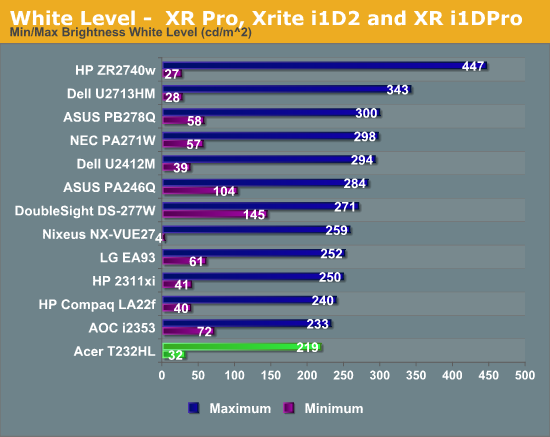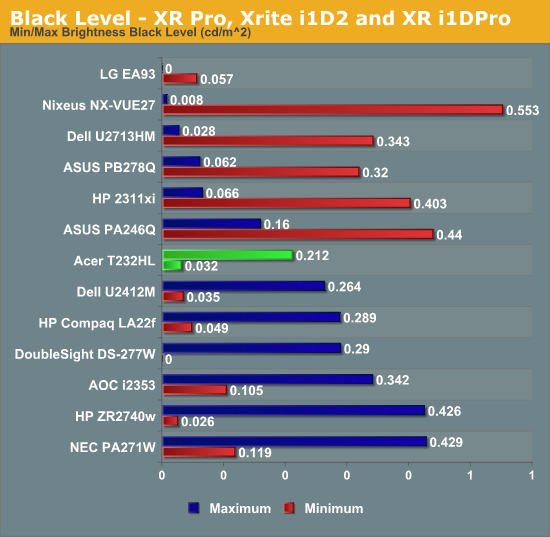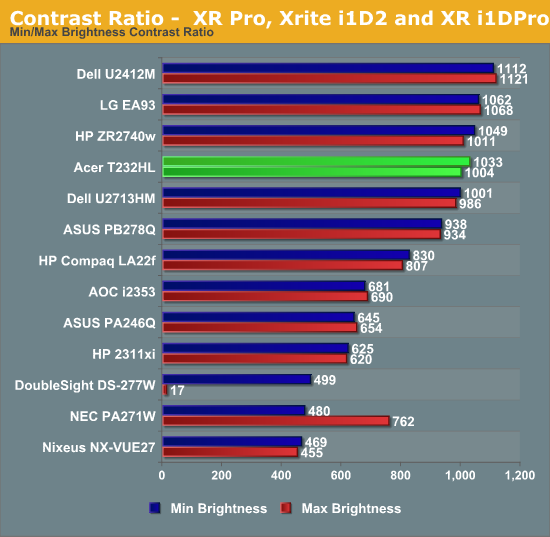Acer T232HL - Touch Comes to the Desktop
by Chris Heinonen on February 6, 2013 9:00 AM ESTBrightness and Contrast
The Acer T232HL uses an IPS panel with LED lighting, so my main curiosity on it was if the touch layer would have a negative impact on brightness and contrast ratios. We’ve seen phones and tablets that maintain very good contrast ratios, but they utilize much smaller screens. With a 23” display I expect to have a good amount of light output, and here the Acer only managed to produce 219 nits with the backlight at maximum. This comes in a bit behind other 23” monitors that I’ve reviewed recently and well behind all the 27” displays that I’ve seen. With the backlight at minimum I managed to get 32 nits out, so you can reduce the light output as much as you would likely want to be able to.

Black level is 0.212 nits with the backlight at maximum and down to 0.032 nits with the backlight at its minimum value. These wind up being really good for a smaller IPS panel, as they typically are a good amount higher. Going back to the touch layer, I’ve no way to test it but if that layer is absorbing 0.1 nits of light, that would lead to almost no change at the white level, but a huge change in the black level.

This small change would make a large change in the contrast levels, and that might account for the contrast levels that I saw in the Acer. Maximum backlight had a contrast of 1033 and minimum had a level of 1004. These are really nice levels and lead to an image with a lot of dynamic punch. The glass front helps to accentuate this a bit as well in comparison to a matte finish, making the Acer really stand out.

I wish the peak brightness on the Acer was better, as 250-300 nits should be the minimum that a monitor can deliver in my opinion. The reflective nature of the glass makes this even more important to me since if you are getting reflections from your lighting, you’ll want to crank the panel backlight up to compensate. If you don’t have glare issues, then the Acer produces contrast numbers that are really nice to see.










66 Comments
View All Comments
Patanjali - Friday, April 5, 2013 - link
And it ISN'T here yet. In May we will see whether it lives up to the hype. We still don't know how fine the control is, and whether you can use it in existing apps as easy as touch.Certainly, if the supplied software allows acurately touching a button in an existing app then it will be a winner. However, "But with the Leap Motion Controller and our apps, nothing's holding hands and fingers back." reads like it ONLY works with stuff programmed for it, which severly limits its general use. It may well end up as ANOTHER interaction method, along with keyboard, mouse, touch and whatever else comes along.
As it is now, using a touchscreen with Windows allows ANY app to be touch controlled. Of course, it may not be optimal, but having got used to accurately touching tiny links in web page on my phone, touching the tiny X button in the upper right of a window to close it is no big deal.
With Leap Motion, how will it be used with multiple monitors?
How fine-grained can control be when you are holding your hand in mid air? And what about arm fatigue?
UltraTech79 - Monday, February 11, 2013 - link
Great! Now my arm can get tired while my arm gets tired.Patanjali - Friday, April 5, 2013 - link
I have been using multiple 30" monitors with two Dell ST2220T touchscreens for the last year. I bought the touchscreens to use for DAW work to place mixing windows and various other dialogs that would be useful to be able to touch.The touchscreens I have at a low angle sloping up to the bottom of the two 30" monitors. The single biggiest maintainability issue with the touchscreens is NOT fingerprints but DUST. It is amazing how much dust accumulates on a horizontal surface in 24 hours. Fortunately Dell supplied excellent cloths which makes it easy to clean off the dust and finger smudges. Such low angles are the ONLY way to use touchscreens a lot.
However, after having touchscreens, I wish ALL the monitors were touch as even with the large vertical monitors it would be nice to just reach out and do the occasional scroll of a web page or document or adjust a DAW control that I couldn't fit on the touchscreens. Touch is so direct whereas reaching for a mouse just to do such things that are so quick for a hand seems a distraction to workflow now.
The Dell touchscreens worked for Win7 OK, but using optical tech, are not really up to being used with all the Win8 geatures, which is why I am reading reviews like this. I am still wanting 27" 2560x1440 touchscreens like those used on the Dell all-in-ones. I would get four of those!
As for glossy screens, they work OK for small portable devices where you can easily adjust the viewing angle to avoid reflections, or when sitting in low light watching TV, but they are a MAJOR pain when used in fixed situations in normal illumination. The touchscreens, being at a low angle, reflect the image showing on the bottom part of the 30" monitors above them! If it was your only monitor, you would have to position it so that it didn't reflect your overhead lighting.
The 30" monitors are the Dell non-glare, wide colour gamut ones which are excellent for viewing and, in my opinion, should be what ALL monitor screens should be like. Excellent colour and illumination and NO reflections at all.
Apparently the Planar Helium 27" touchscreen is matte, but it would take up a lot of deskspace while only providing 1920x1080. The LG 2560x1080 monitors would have been great if they were touchscreen (and matte).
I hope when 4K monitors (3840x2160 = 8Mpx) start appearing, they are are available with matte touchscreens as well.
As for multi-monitor usage with Win8, I don't know what people seem so uptight about. Yes, it is best to have the start screen mainly on a smaller, close-at-hand, sloped monitor, but default behaviour on my system is that the start screen disappears as soon as the mouse is clicked in ANY 'desktop' area, so it is basically a popup screen when you need it rather than the principal interaction area as when used on a tablet or single monitor.
It may well stay alive if the touchscreen is a Win8 certified one, but someone else would have to let us know if that is the case.
I have an Acer W511 3G Win8 tablet and it is very easy to use and, because of the instant on and constant internet connection, it is very quick for me to check email in Outlook or look on the internet, whereas it was a slow pain with my previous laptop, waiting for it to boot up and for the 3G modem software to kick in. And Win tablets are SO much easier to use with a home network.
For me Win8 works both on a tablet and my large multi-monitor system, and its operation is appropriate to each. Oh, and while some so-called tech bloggers and commenters made a big noise about the loss of the start menu, MS telemetry showed that most users had got the hint with Win7 and shifted their focus to the taskbar, which is alive and well and on every desktop screen in Win8. Basically, on a multi-monitor setup, the start screen is like a big visual menu which can be configured to put all your commands into groups in any order you want.
osx77 - Friday, May 17, 2013 - link
Hi i have a question is this monitor led or lcd?Because i try to find info on amazon.com and it said LCD so which is it.and other pages said is Led so...
thanks
dpars - Monday, December 30, 2013 - link
Using acer t232hl with mac mini??dpars - Monday, December 30, 2013 - link
I'm connected with HDMI and USB 3.0 using bluetooth keyboard and magic trackpad. I have a fully-functional, unresponsive touchscreen monitor… Thoughts?